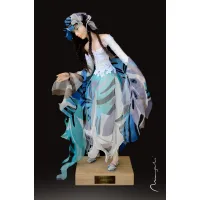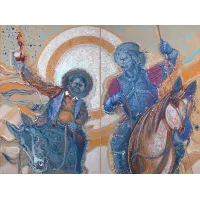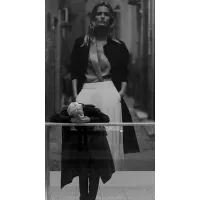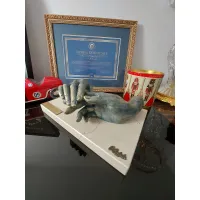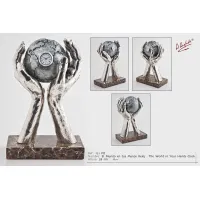A painting made around 1950, showing a composition of flowers, signed U. Montini
Luxury furniture and antique accessories
SKU: ANT-A212
See other products from category Antiques and art or from manufacturer Antyki
Description
Vase Montini Umberto. A painting created around 1950, depicting a composition of flowers, signed at the bottom left by U. Montini, by the Milanese artist Umberto Montini (Milan 1897 - Busto Arsizio 1978).
The work is painted in oil on canvas, with quick and energetic brushstrokes, often textured, but always intense, in bright colors. The painting is fresh and decorative, featuring a bouquet composed of common and multicolored flowers, daisies, poppies, gladioli, gathered in a chaotic vase. The painting is in perfect condition, in a modern frame.
Umberto Montini (Milan 1897 - Busto Arsizio 1978) Employed at a young age in a lithographic laboratory due to the difficult economic situation of his family, he attended evening courses in Brera until 1920, when he was able to enroll in the Academy, where he graduated in painting in 1924 under the guidance of Ambrogio Alciati. From that moment, he exhibited continuously at the Milanese Permanente exhibitions and Lombard unions, gaining worldwide fame by participating in the Venice Biennale (1928, 1930), the exhibition in Barcelona in 1929, and the Paris Universal Exhibition in 1937; in 1938 and 1956, he also tested the South American market, traveling to Peru and Ecuador. A friend of the brothers Ernesto and Leonardo Bazzaro, he preferred landscape painting and Milanese views captured with quick brushstrokes in the misty atmosphere of winter days. Significant in this regard are four works preserved in the Galleria d’Arte Moderna in Milan, one of which, Day of Fog, won the Sallustio Fornara award at the Permanente in 1935. Four years earlier, the artist received the Mylius Prize for a historical landscape at the Brera exhibition.
Prestigious antique furniture and accessories can be an excellent idea for decorating our interiors. Nowadays, there are more and more enthusiasts of high-quality old products that have a specific character and soul. It is a nod to the history, creation, and design of classic and timeless furniture. There are many different styles in antique furniture, each with its distinctive features.
There are many different styles characterizing antique furniture, but we can distinguish a few of the most important ones. Eclectic furniture belongs to the 19th century, during which the Biedermeier style reigned. Its variations in the early years of this century include Neo-Gothic, Gothic, Rococo, Louis Philippe style, and finally the English Victorian style. By the end of the century, these styles transitioned into pseudo-styles of Classicism, Renaissance, and Baroque.
Empire-style furniture and accessories date from the late 18th to the early 19th century. It all originated during Napoleon's reign. There, a significant resemblance and references to Roman and Greek decorations were imposed.
Classicist furniture refers to the Louis XVI style, which also strongly draws from ancient architecture. Interesting and noteworthy are all antique products in the Rococo and Louis XV styles. Next is Baroque, whose name comes from the Portuguese barocco – which translates to an irregularly shaped pearl. These were very representative pieces of furniture, meant to literally ooze splendor and play a significant role in luxury. Exceptional, selectively used materials were employed to further emphasize the grand tone of these products.
Today, we can observe how much influence the Baroque style had on today's classic furniture, which is designed with great similarity to the past era. Another significant style is the Renaissance, which flourished in the 15th and 16th centuries and also left a significant mark on the art of furniture making. The Renaissance style was quite heavy and massive. Brown stains were used, as well as cornices, strong plinths, and bas-reliefs. It can certainly be said that these were quite specific products, but they provided many new possibilities such as the construction of the sideboard, or generally broadly understood chest furniture. Here, there was also an interest in mythology and ancient times, so supports or legs took on animal forms.
Lion's paws, eagle heads – these are common features in Renaissance style. Currently, many global brands are recreating such furniture, drawing inspiration from Italian and French creators. This is a manifestation of admiration and care for the history of the most beautiful Renaissance antiques. It is important to remember that each country had a different perception of furniture making, so each style in a given country had its own distinct character. This is very important, especially when searching for the right elegant antique for your interior. The most important aspect of prestigious antique furniture is originality. This is ultimately crucial from the buyer's perspective, as there are many counterfeits on the market. Luxury Products provides a document confirming the product's compliance with the actual description and photo. At your disposal, we have art appraisers, historians, and experts from around the world.
Attributes / Details
| SKU | ANT-A212 |
| Manufacturer | Antyki |
| Model | A212 |
| Size | Height: 70 cm Width: 50 cm |
| Wiek | XX |
| Rok | 1950 |
| Destiny | To living room |
See catalog
Reviews
No reviews for this product.









